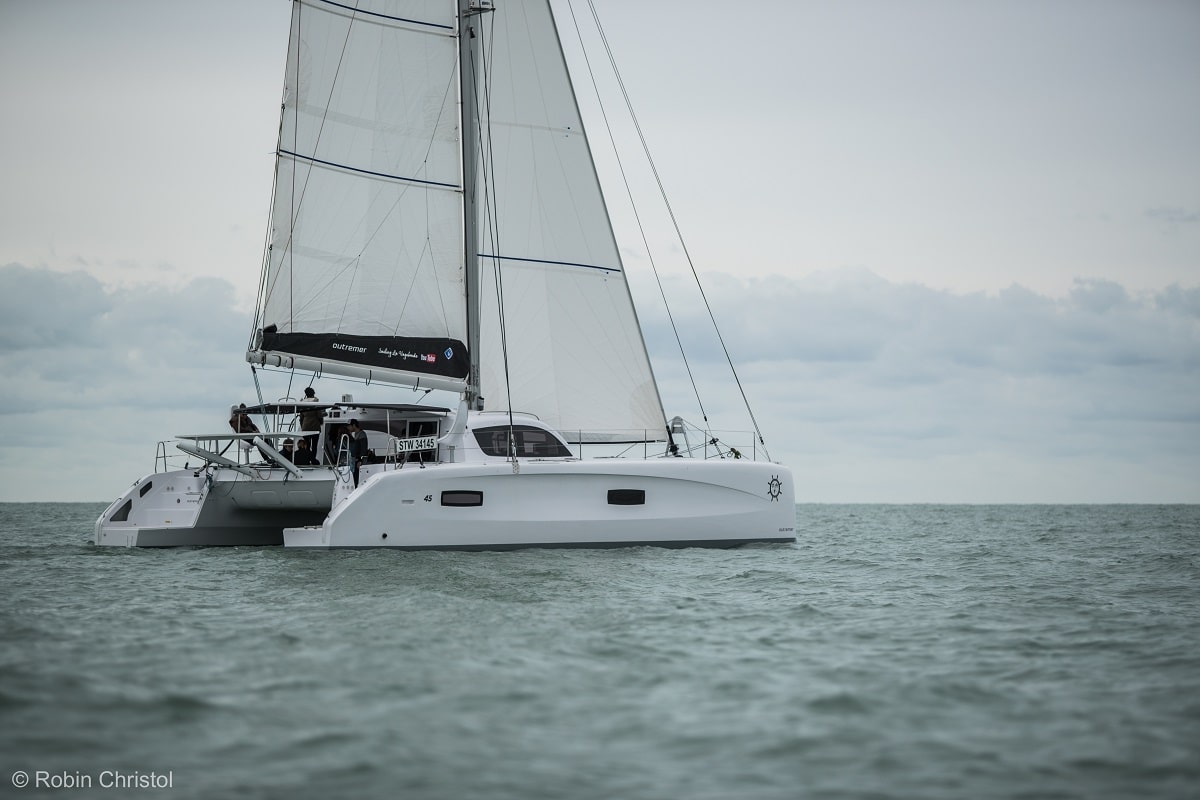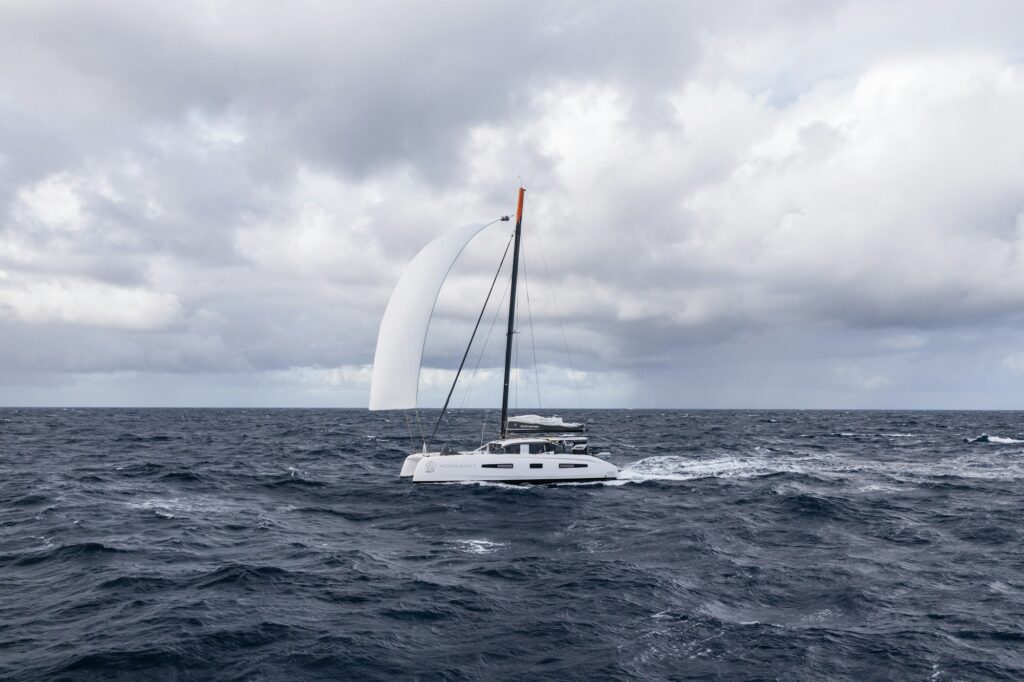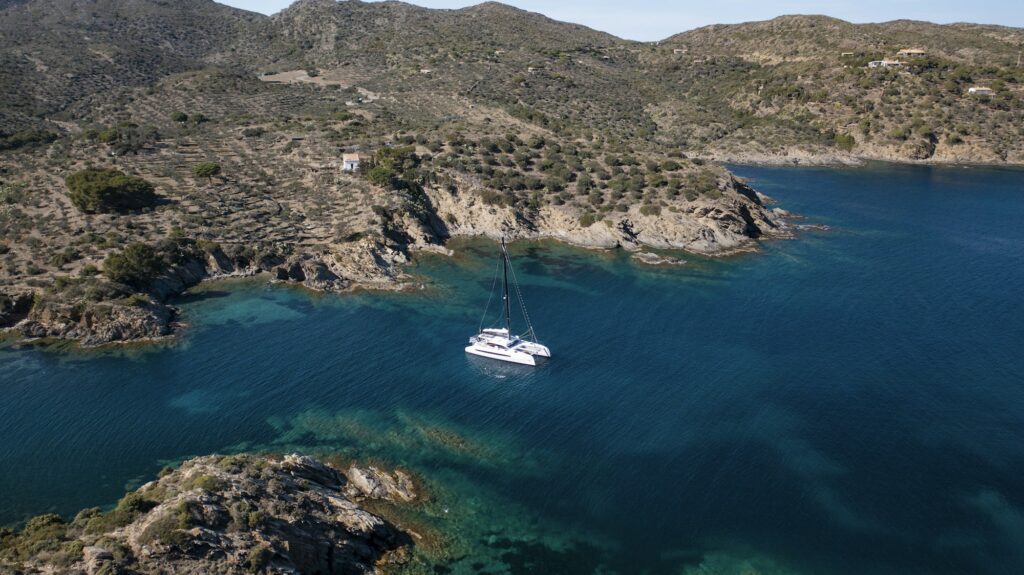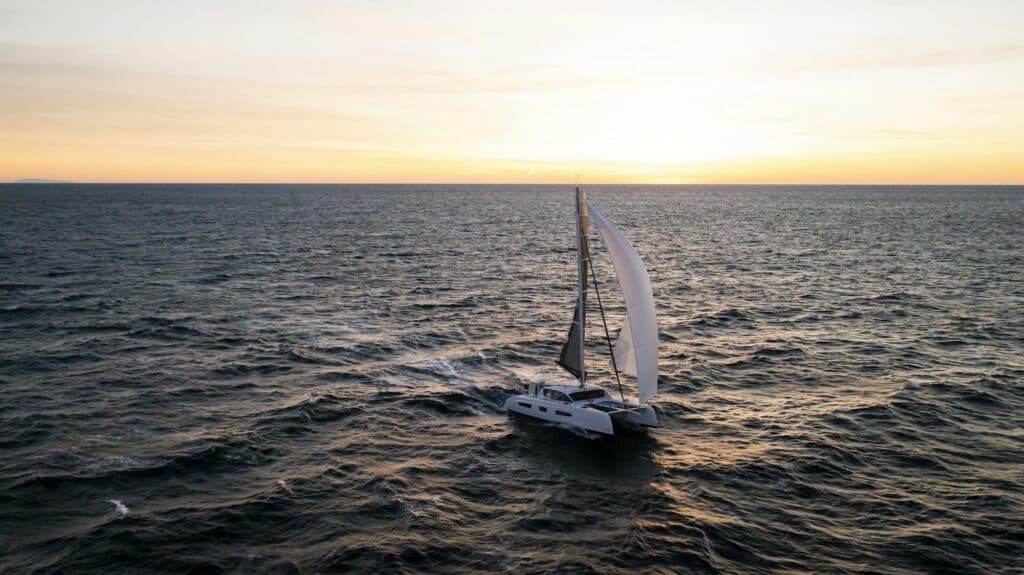
Author: Nikki Henderson
When I look back on the crossing on La Vagabonde, my brain does a remarkably clever thing. It filters out most of the hard stuff: the lightning, the stress, the responsibility, the social media flurry, the awkward moments between the diverse characters. What’s left, is memories of day 12 onwards and the tales I find myself telling are of the epic speeds, and the surfing waves, and the incredible friends I made. Just that day was enough to turn the previous 12 on their heads.
If I were to buy an Outremer, I would buy it especially for day 12, and the remaining last six days. La Vagabonde was made for the conditions. Due to our southerly position in relation to the low pressure systems rolling north eastwards across the North Atlantic, we had the perfect combination of 25-35 knots of wind but a very minimal sea state. Well until the end! Without the waves, the risk of bow diving was so much less that we could sail generously canvassed and absolutely scream along. Quite a juxtaposition from the first half of the voyage.
Outremer pride themselves on the safety of their yachts. One key safety feature that they identify, and that sets them apart from many other multihull brands, is speed. They understand the theory: the better the boat sails (aka fast and in good directions) with relation to the wind, the less powerless you are to mother nature; the faster you go the more control you have. By control I mean you have choices. Choices to slow down or speed up.
Why would you want to slow down you ask? Well a good example would be if you are on a collision course with a dangerous weather pattern, and want to let it pass in front of you. We did this on that trip, reducing sail and pointing a little closer to the wind and allowing Tropical Storm Sebastien swirl ahead of our track. If the wind shifted behind us we also knew we had the option to trail lines too.
In the same wane, you also have a choice to go really quite fast. This has many safety benefits.
- It’s a safety blanket for rookie routing decisions, and you can make quite last minute strategies if you didn’t consider weather patterns far enough ahead of time.
This is exactly what we were doing on that voyage at the beginning – making ground south to ensure we were far away from the very windy and wavy centres of the systems rolling across the Atlantic – some of which caught us quite off guard!
- On a smaller scale, you are able to shift away from large squalls or clouds you see on the radar much more effectively than if you are limited to only 5 or 6 knots boat speed.
- As well as avoiding weather, you can also ensure you sail in it. The last three or four days of that crossing were brilliant. Well positioned for a huge anticlockwise flowing system, we managed to sail in its bottom right section for days. We screamed along in its W-S-W winds averaging over 10 knots a day; therefore, sailing almost the same speed as it. That way we avoided the fury of the cold front on the bottom left of the system until we were closer to the safety of shore, and also managed to get safely docked in Lisbon before the light unstable winds behind it left us becalmed.
This speed is one of the main reasons why La Vagabonde, the Outremer 45, along with many other more powerful performance boats can brave the unseasonable crossings, when cruising boats cannot. Keep note on the Vendee Globe for an example – they will for sure start playing the lows in the southern-ocean in exactly the way I described in #3 (although times 10 knots threefold!).
Returning to my dreamy memory of that last week of the North Altantic… Watching the numbers on the instruments was hypnotic. All of us – particularly Svante – would sit at the nav seat and stare at the 10 – 11 – 12 knot averages, surfing to 18 – 19 – over 20, again and again.
There is nothing better than that feeling of the boat beginning to accelerate. There is this magical moment somewhere between surfing and flying, in a delicate equilibrium between air and water where the boat just takes off. It’s not an acceleration like a roller-coaster or sports car – the slam to the back of your seat, butterflies in your tummy – it’s more of a gliding surfing sensation – like syrup pouring onto pancakes, like thick warmed but not frothed milk blending into an expresso shot, the firm slide of a massaging hand on your back – not oily – not dry – that luxurious point in the middle of watery and solid – oozing, but clean. Just magical. That was sailing downwind on the Outremer in flat sea and a strong breeze.
Type 2 fun is about turning something that is full of hardship, grief and pain – into an adventure. It is about seeing a challenge like an unseasonable crossing, like a solo circumnavigation, like a year of lockdowns and Covid19, as an opportunity rich with potential for positivity. No one enjoys the stress of sailing, the cold, the wet, the harsh words, the fear, the risk. What they enjoy is the hindsight of it. The drama. The sense of achievement they feel standing on the beach looking out onto the waves and thinking to themselves, “wow 3000 miles. Did I just do that?!”
This year I have spent more consecutive days on land than I have in the past ten years. In that time, I’ve been soul searching – looking for my next calling – my next adventure or purpose. Naturally, I have been reflecting on whether that will or will not involve sailing. Directly following a period of intense time on the water, I tend to think that I want to give up sailing as a career. I become worn down by the elements, by the responsibility, by the risk. I find myself thinking that life would be so much easier on land. But over time, I begin to miss it. I realise my life feels less fulfilling on land. The sea is my calling. I can feel the gentle hand of mother nature tugging at my heart strings – luring me back to her uncertainty, and danger, and relentlessness. It is pulled back because I am able to architect some space from it – enough space to free up the memories of beauty, and horizons, and fun, and relationships, and all those spectacular precious moments that you can only find in the middle of the ocean.
For anyone who is questioning whether sailing is for them… I urge you to push through the difficult times, the fear, the seasickness – or whatever it is that is so off putting – and see if you can persevere it long enough to find the magic on the other side. It is so worth it.
As we watch the Vendee Globe unfold, and the wrath of the Southern Ocean soon take over the sailors’ focus, I certainly will be paying close attention to their silver linings that keep them fighting. The albatross, the isolation, the beauty – or whatever it is – that keeps pulling these incredible people back to the most desolate places and the most challenging sport on this planet.



